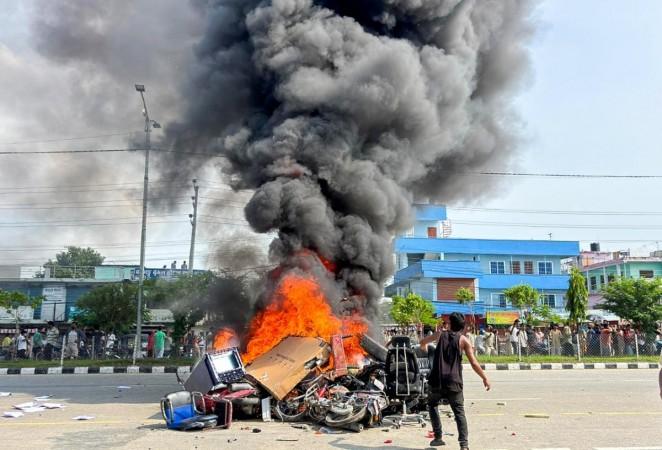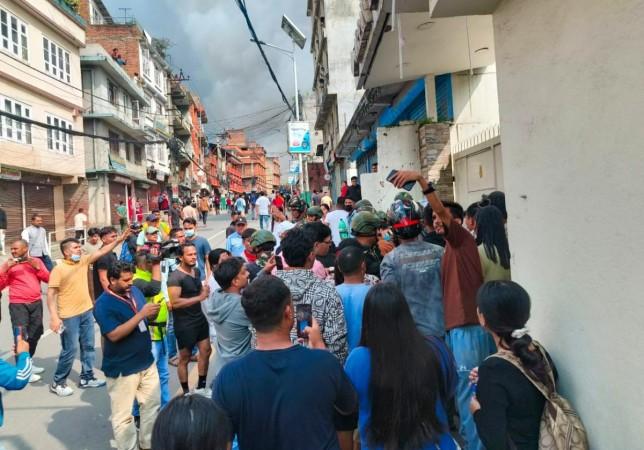
Nepal is getting engulfed by unprecedented unrest as youth-led protests erupted from the government's abrupt and controversial ban on 26 major social media platforms including Facebook, Instagram, WhatsApp, YouTube, and X. The move was widely seen not merely as a regulation of digital communication but as an attempt to suppress a burgeoning anti-corruption movement spearheaded by the country's Gen Z, which constitutes approximately 20.8% of Nepal's population. These protests, fueled by longstanding grievances over entrenched corruption, nepotism, economic marginalization, and political suppression, escalated quickly, resulting in violent confrontations that left at least 19 dead and hundreds injured. Government buildings, including the parliament, and residences of senior political figures were vandalized or set ablaze. Prime Minister K.P. Sharma Oli resigned amid the chaos, marking one of the most severe crises Nepal has faced in decades.
The turmoil unfolds in a region where Bangladesh and Sri Lanka have recently faced parallel crises stemming from economic sluggishness, governance failures, and social discord. These nations collectively expose vulnerabilities common in emerging countries with fragile institutions and rapidly changing social dynamics dynamics susceptible to exploitation by divisive political narratives and misinformation.
The threat posed by these fractures extends beyond national boundaries. Fragile democracies and developing economies worldwide confront similar risks wherein dissatisfaction, misinformation, and political manipulation can ignite rapid destabilization. India's vast scale, robust democratic institutions, and relatively strong governance apparatus provide a natural safeguard against such sudden upheavals. Even so, the Nepal crisis offers a mirror for India itself, demanding rigorous evaluation of its socio-political vulnerabilities. Vigilance, reform, and continued institutional strengthening become essential for India to remain a beacon of stability and encourage positive regional transformation.
Sowing Fragmentation: The Weaponization of Identity, Faith, and Political Division
Nepal's crisis vividly illustrates how identity whether religious, ethnic, or regional is manipulated by political actors to consolidate power by dividing societies. Religion, traditionally a source of unity, has been distorted into sectarianism. Ethnic and caste identities have been politicized, fueling exclusion and competition rather than solidarity. This fracture in social bonds produces a zero-sum political culture where communal loyalty overrides national cohesion.
The Nepali youth's explicit distancing from established political parties reflects a rejection of traditional factionalism and corruption. But this leadership vacuum has been exploited by elements spreading divisive and often extremist narratives, deepening societal polarization. The political landscape here and in similar contexts is marred by attempts to engineer votes and loyalty along fragile identity lines, which impair democratic processes and social trust.
The Digital Dilemma: Social Media's Algorithmic Polarization and its Real-World Fallout
The 2025 ban of 26 social media apps followed enforcement of the Social Media Bill, mandating platforms to register with Nepal's government and regulate content locally. Though TikTok and a few others complied, major platforms including Facebook, Instagram, WhatsApp, X, YouTube, Reddit, and LinkedIn did not meet the deadline and were blocked. This action cut off nearly half Nepal's population, estimated at 14.3 million active social media users, from key digital spaces fundamental for communication, education, business, and socio-political mobilization.
Social media algorithms, driven by engagement metrics, tend to amplify polarizing, sensational, or emotionally charged content, fostering 'affective polarization' a phenomenon wherein people's identity-based emotional loyalties deepen while mistrust and hostility toward out-groups intensify. Research from 2024-2025 affirms this, showing users are nudged into echo chambers or "filter bubbles" that limit exposure to diverse viewpoints, making dialogue and consensus-building harder.

In Nepal, youth leveraged TikTok one of the few accessible platforms to expose corruption, connect protests, and galvanize action. Yet, the government's sudden ban was viewed as an assault on digital freedom and a tool for silencing dissent, sparking outrage among a digitally connected generation expecting openness and accountability.
Psychologically, human tendencies like confirmation bias and perceived threats to identity reinforce divisions, allowing misinformation and hate to flourish on polarized platforms, further destabilizing the social fabric.
Economic Marginalization and Youth Discontent
Nepal's Gen Z, constituting 20.8% of the population aged 16-25, represent a demographic beleaguered by limited economic prospects. Official unemployment stands around 12.6%, but significant informal sector underemployment and seasonal labor mean the effective unemployment is likely much higher. Youth complain of lack of meaningful opportunities and deep-rooted political patronage ("Nepo Kids") that prevents merit-based advancement.
Nepal's dependence on remittances from around two million workers abroad adds another layer of economic fragility. The social media ban severed vital communication lines for families dependent on migrant earnings, intensifying economic and social stress.
The protests reflect this profound generational disillusionment, with young people demanding not only the lifting of digital restrictions but radical ends to the systemic corruption and nepotism choking economic and democratic breathing space.
Governance, Crime, and Corruption: Erosion of Public Trust
Governance in Nepal suffers chronic weaknesses. Corruption permeates political, bureaucratic, and economic systems, undermining equitable resource distribution and public service delivery. Nepotism, favoritism, and lack of accountability erode confidence in institutions.
Criminal networks, such as drug trafficking and smuggling enterprises, thrive amid this systemic dysfunction. Political patronage frequently shields illicit activities, weakening law enforcement and judiciary independence. Police and judicial institutions are often politicized or lack resources and training, contributing to cycles of impunity and social disorder.
This nexus of corruption and crime contributed directly to the volatile clashes during the protests, exposing the state's fragility and governance deficits.
Societal and Spiritual Fragmentation
The worsening economic and political crisis has societal consequences beyond agitation and unrest. Faith and religious identity, once sources of societal unity and resilience, have been exploited for political ends.
In Nepal and neighboring countries, majoritarian narratives sometimes marginalize ethnic and religious minorities, eroding the pluralistic traditions that hold diverse societies together. This manipulation undermines social trust and fosters fear and alienation, contributing to communal tensions and potential conflict escalation.
India's Subtle but Serious Challenges
India's democratic institutions and scale provide resilience compared to Nepal. However, India faces its own rising challenges: social polarization along religious and caste lines, erosion of institutional independence, increasing influence of weaponized nationalism, manipulation of electoral processes, and weakening of law enforcement impartiality.
Digital misinformation and social media polarization amplify societal divisions in India as elsewhere. Economic inequalities and youth unemployment compound social tensions.
Recognizing these challenges with rigor and resisting complacency is critical for India's continued democratic stability and regional leadership.
Toward Inclusive and Sustainable Stability
Nepal's crisis and regional echoes serve as a sobering reminder of vulnerabilities facing emergent democracies. Their lessons underline the necessity of transparent governance, inclusive narratives, institutional independence, empowered civil society, digital literacy, and youth economic empowerment.
India, while relatively stable, must heed these warnings and commit to deep reforms to preserve democratic values, social cohesion, and economic opportunity for all its citizens.
[Major General Dr. Dilawar Singh, IAV, is a distinguished strategist having held senior positions in technology, defence, and corporate governance. He serves on global boards and advises on leadership, emerging technologies, and strategic affairs, with a focus on aligning India's interests in the evolving global technological order.]

















